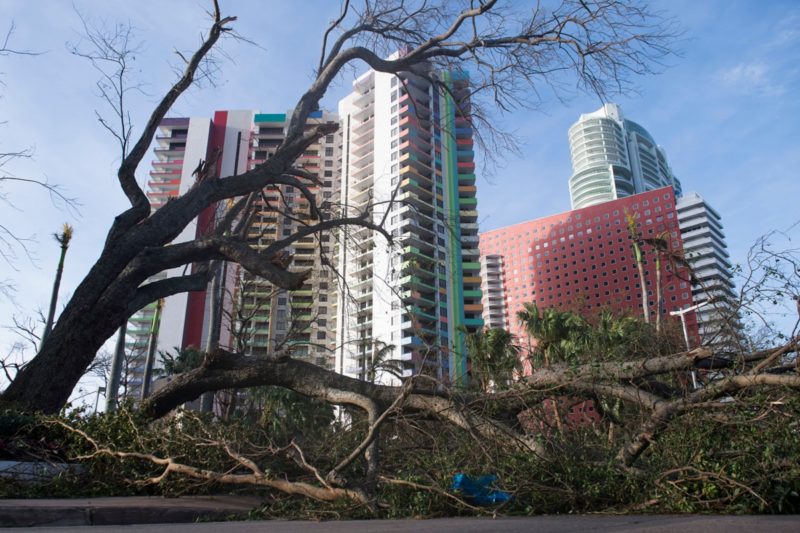As Irma Cleanup Proceeds, Miami Area Still Faces Obstacles
Storm debris still litters some streets, making driving, walking, and getting to grocery stores difficult for some residents. And then there are potential public-health issues.

Though Hurricane Irma ravaged South Florida more than a month ago, parts of Miami-Dade County look as if the storm struck the region just yesterday. Fallen trees and rotting palm leaves are littered across residential neighborhoods and commercial zones.
Despite slow and steady cleanup efforts, the City of Miami estimates it will take between four to six months before the area returns to normalcy, and this plodding progress is already causing issues for local residents.
Weeks after the storm, many residents still find their day-to-day life affected by Hurricane Irma. This is especially true for anyone who drives in the metro area, including thousands of Uber drivers.
Jorge Rodriguez, an Uber driver in Kendall, Florida, says roads littered with debris affect his ability to drive throughout Miami-Dade.
Rodriguez said in Spanish, “The majority of the city is covered in garbage because so many trees fell, and in many parts when you’re driving on the avenues or streets in residential neighborhoods, there’s also a bunch of garbage.”
To avoid crashing into the debris, Rodriguez must slow down in these neighborhoods and proceed with extra caution—and even something as small as a few minutes’ delay can cost Uber drivers a customer, thus limiting the money they can earn in a shift.
The storm debris problem has been exacerbated by residents throwing trash on piles of dead leaves and tree bark. City contractors hired to move storm-related debris have been instructed to not pick up vegetable refuse that has been mixed with garbage. The city resumed trash pickup within days after Irma’s passing, but removing bulkier items such as furniture has always required residents to call a number to request the large trash be removed within one day. So there may be combined piles of trees, damaged household items or materials, and regular trash—which then won’t get picked up.
For individuals who bike to work or walk to the bus stop, this debris can create deadly conditions. Already considered one of the least walkable metro areas in the nation, Miami is an automobile-centered city with little infrastructure designed for pedestrians. This issue is endemic across Florida, where eight of the top 10 deadliest U.S. cities for pedestrians are located. The Miami-Fort Lauderdale-West Palm Beach area ranks 11th on the list, which is updated annually to include car-related fatalities for pedestrians.
“If you’re walking on the sidewalk, there’s a lot of garbage, and so people have to walk in the street,” Rodriguez said. “It’s more dangerous because if a car comes, they’re going to be hit.”
Impeded access to public transportation and maneuverable sidewalks creates an even deeper chasm between Miami’s driving population and those who rely on public transportation. Since Miami is known for its high parking prices and terrible traffic, owning and operating a vehicle is a privilege afforded to individuals who have the money and time to be able to use their own car. Miami public transportation, which is already already lackluster and limited, is primarily used by the county’s lower-income or middle-class commuters.
According to Luis Espinoza, special projects administrator at the Miami-Dade Department of Regulatory and Economic Resources, the majority of Irma-related public transportation issues have been resolved. He said that as of October 15, public works staff have worked with local departments to pick up more than 1.5 million cubic yards of debris from county roads.
“Thanks in part to this team effort, our customers are now able to catch the bus at our regularly designated bus stops,” he wrote in an email to Rewire. As of October 11, however, the City reported it needed at least another 60 to 90 days to restore Miami to its former state and that nearly 60 percent of the cleanup was finished.
In other parts of Miami-Dade County, however, more issues emerged as cleanup was under way. For Liberty City resident Valencia Gunder, founder of Make the Homeless Smile, her majority low-income neighborhood was slow to regain electricity and grocery stores were slow to restock. This initial food shortage was largely due to clogged roads straining food delivery systems. Furthermore, individuals who remained in the metro area and left in search of food encountered nightmarish traffic, which limited their ability to search for nonperishable food in the days after the storm.
“Our community didn’t get the response it deserved after the storm,” she said. “Because of equity, certain people were put in a worse situation than others. Food scarcity was a big thing. Grocery stores were empty for many days after the storm, so people didn’t have access.”
However, Gunder’s hurricane-related issues have grown in recent weeks as the Poinciana part of her city has become a makeshift landfill. “It stinks like crap,” she said. “It stinks, and some of the residents are saying they’ve seen an increase of rats and possums.”
Abandoned vegetation debris is known to cause various public health issues by becoming a home for mice and enormous pythons, and fast-growing mold can be a source of respiratory complications. For Gunder, though, the issue extends beyond her physical well-being.
“I just really wish [authorities responsible for cleanup] respected everybody,” she said. “You know for a fact they aren’t going to put piles of trash in Coral Gables or Miami Beach or Brickell. That’s what I mean by equity. If you wouldn’t do it in one community, don’t do it in ours.”
